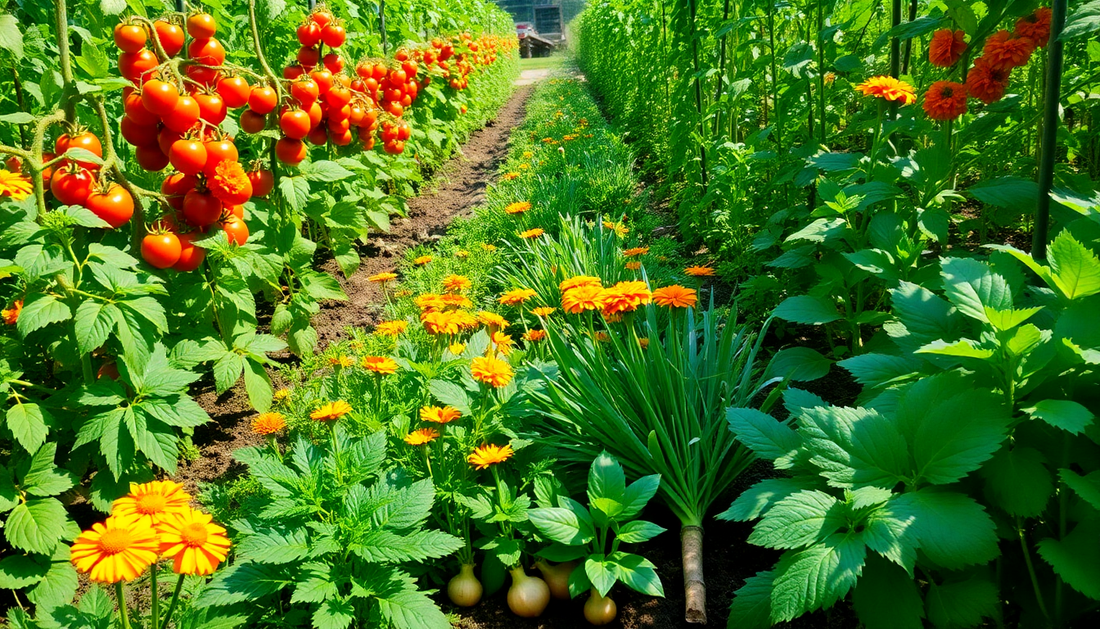
Companion Plants to Maximize Vegetable Growth
Share
As gardeners, we all strive to cultivate thriving vegetable patches that not only provide us with fresh, nutritious produce but also create a harmonious and sustainable ecosystem. One of the most effective ways to achieve this is through the strategic use of companion planting. In this comprehensive blog post, we'll explore the art and science of companion plants, uncovering how they can help maximize the growth and health of your vegetable garden.
The Principles of Companion Planting
Companion planting is the practice of growing different plants in close proximity to one another, with the goal of harnessing the natural synergies and benefits that these plants can provide. By carefully selecting and arranging your vegetable crops and their companion plants, you can create a dynamic and mutually beneficial relationship that enhances the overall productivity and resilience of your garden.
At the heart of companion planting lies the principle of biodiversity. By incorporating a diverse array of plants, you create a more balanced and resilient ecosystem, one that is better equipped to withstand pests, diseases, and environmental stresses. This diversity also encourages the presence of beneficial insects, pollinators, and microorganisms, all of which play crucial roles in maintaining the health and vitality of your vegetable garden.
Companion Plants for Pest Control
One of the primary benefits of companion planting is its ability to deter and manage pests. Certain plants possess natural compounds or physical characteristics that can repel or confuse harmful insects, protecting your vegetables from damage and reducing the need for chemical pesticides.
For example, marigolds are known to release a strong scent that can deter aphids, nematodes, and other common garden pests. Planting marigolds around the perimeter of your vegetable beds or interspersed throughout can create a natural barrier against these unwanted visitors.
Companion plants like basil, rosemary, and lavender can also help to confuse and disorient pests, making it more difficult for them to locate and attack your vegetables. These aromatic herbs can be strategically placed near susceptible crops, creating a fragrant and inhospitable environment for many garden pests.
Nutrient-Sharing and Soil Improvement
In addition to pest control, companion plants can also play a vital role in improving the overall health and fertility of your soil. Some plants are capable of "fixing" atmospheric nitrogen, converting it into a form that can be readily absorbed by other plants. Legumes, such as peas and beans, are excellent nitrogen-fixers and can be grown alongside heavy nitrogen-feeding crops like tomatoes or corn.
Other companion plants, like comfrey and yarrow, have deep taproots that can help to break up compacted soil and bring essential nutrients to the surface, making them available to your vegetable crops. By strategically placing these nutrient-accumulating plants around your garden, you can create a self-sustaining cycle of soil improvement and nutrient cycling.
Companion Planting for Increased Yields
Beyond pest control and soil health, companion planting can also directly contribute to increased yields and overall vegetable production. This is achieved through a variety of mechanisms, including:
Spatial Efficiency
By carefully arranging your vegetable crops and their companion plants, you can maximize the use of available space in your garden. For instance, planting tall crops like corn or pole beans alongside shorter, spreading plants like pumpkins or squash can create a layered and efficient system, where each plant occupies a different vertical niche.
Pollination and Biodiversity
Companion plants that attract beneficial insects, such as pollinators and predatory insects, can significantly enhance the pollination and natural pest control services in your vegetable garden. This, in turn, can lead to higher yields and healthier, more abundant harvests.
Microclimate Regulation
Certain companion plants can help to regulate the microclimate around your vegetables, providing shade, wind protection, or increased humidity as needed. This can help to mitigate environmental stresses and create more favorable growing conditions for your crops.
Companion Planting Strategies
When it comes to implementing companion planting in your vegetable garden, there are several strategies and techniques to consider. Here are a few key approaches:
Polyculture Planting
Polyculture planting involves growing a diverse mix of vegetables, herbs, and flowers together in the same bed or area. This creates a more complex and resilient ecosystem, where each plant plays a complementary role in supporting the others.
Intercropping
Intercropping involves planting two or more crops in the same space, but at different times or in different layers. For example, you might sow a fast-growing crop like radishes between rows of slower-growing vegetables, such as carrots or beets.
Trap Cropping
Trap cropping involves planting certain plants that are more attractive to pests, drawing them away from your valuable vegetable crops. These "trap" plants can then be removed or treated to eliminate the pest problem.
Companion Planting Guilds
Companion planting guilds are carefully curated groupings of plants that work together to create a self-sustaining and mutually beneficial ecosystem. These guilds often include a mix of vegetables, herbs, flowers, and even perennial plants.
Putting It All Together
Implementing a successful companion planting strategy in your vegetable garden requires a combination of research, experimentation, and keen observation. Start by identifying the specific challenges and goals you have for your garden, and then explore the wealth of companion plant pairings and techniques that can help you achieve those objectives.
Remember, every garden is unique, and what works well in one location may not be as effective in another. Be prepared to adapt and adjust your approach as you learn more about the specific needs and interactions of the plants in your garden.
By embracing the principles of companion planting, you can create a thriving, resilient, and productive vegetable garden that not only provides you with an abundance of fresh, nutritious produce but also contributes to the overall health and biodiversity of your local ecosystem. Happy gardening!
